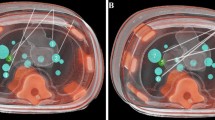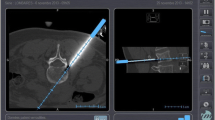Abstract
Purpose
To explore the possible benefits of electromagnetic (EM) navigation versus conventional fluoroscopy during abdominal aortic endovascular procedures.
Methods
The study was performed on a phantom representing the abdominal aorta. Intraoperative cone beam computed tomography (CBCT) of the phantom was acquired and merged with a preoperative multidetector CT (MDCT). The CBCT was performed with a reference plate fixed to the phantom that, after merging the CBCT with the MDCT, facilitated registration of the MDCT volume with the EM space. An EM field generator was stationed near the phantom. Navigation software was used to display EM-tracked instruments within the 3D image volume. Fluoroscopy was performed using a C-arm system. Five operators performed a series of renal artery cannulations using modified instruments, alternatingly using fluoroscopy or EM navigation as the sole guidance method. Cannulation durations and associated radiation dosages were noted along with the number of cannulations complicated by loss of guidewire insertion.
Results
A total of 120 cannulations were performed. The median cannulation durations were 41.5 and 34.5 s for the fluoroscopy- and EM-guided cannulations, respectively. No significant difference in cannulation duration was found between the two modalities (p = 0.736). Only EM navigation showed a significant reduction in cannulation duration in the latter half of its cannulation series compared with the first half (p = 0.004). The median dose area product for fluoroscopy was 0.0836 \(\hbox {Gy cm}^{2}\). EM-guided cannulations required a one-time CBCT dosage of 3.0278 \(\hbox {Gy cm}^{2}\). Three EM-guided and zero fluoroscopy-guided cannulations experienced loss of guidewire insertion.
Conclusion
Our findings indicate that EM navigation is not inferior to fluoroscopy in terms of the ability to guide endovascular interventions. Its utilization may be of particular interest in complex interventions where adequate visualization or minimal use of contrast agents is critical. In vivo studies featuring an optimized implementation of EM navigation should be conducted.


Similar content being viewed by others
References
Geijer H, Larzon T, Popek R, Beckman KW (2005) Radiation exposure in stent-grafting of abdominal aortic aneurysms. Br J Radiol 78(934):906–912. doi:10.1259/bjr/72629938
Jones C, Badger SA, Boyd CS, Soong CV (2010) The impact of radiation dose exposure during endovascular aneurysm repair on patient safety. J Vasc Surg 52(2):298–302. doi:10.1016/j.jvs.2010.03.004
Thakor AS, Winterbottom A, Mercuri M, Cousins C, Gaunt ME (2011) The radiation burden from increasingly complex endovascular aortic aneurysm repair. Insights into imaging 2(6):699–704
Miller M, Davis M, MacClean C, Davis J, Smith B, Humphries J (1983) Radiation exposure and associated risks to operating-room personnel during use of fluoroscopic guidance for selected orthopaedic surgical procedures. J Bone Jt Surg 65(1):1–4
McCullough PA (2008) Contrast-induced acute kidney injury. J Am Coll Cardiol 51(15):1419–1428
Cleary K, Peters TM (2010) Image-guided interventions: technology review and clinical applications. Annu Rev Biomed Eng 12:119–142. doi:10.1146/annurev-bioeng-070909-105249
Cochennec F, Riga C, Hamady M, Cheshire N, Bicknell C (2013) Improved catheter navigation with 3D electromagnetic guidance. J Endovasc Ther 20(1):39–47. doi:10.1583/12-3951.1
de Ruiter QM, Moll FL, van Herwaarden JA (2015) Current state in tracking and robotic navigation systems for application in endovascular aortic aneurysm repair. J Vasc Surg 61(1):256–264
Manstad-Hulaas F, Tangen GA, Dahl T, Hernes TA, Aadahl P (2012) Three-dimensional electromagnetic navigation vs. fluoroscopy for endovascular aneurysm repair: a prospective feasibility study in patients. J Endovasc Ther 19(1):70–78. doi:10.1583/11-3557.1
Iribarne A, Easterwood R, Chan EY, Yang J, Soni L, Russo MJ, Smith CR, Argenziano M (2011) The golden age of minimally invasive cardiothoracic surgery: current and future perspectives. Future Cardiol 7(3):333–346
Brown L, Thompson S, Greenhalgh R, Powell J (2011) Incidence of cardiovascular events and death after open or endovascular repair of abdominal aortic aneurysm in the randomized EVAR trial 1. Br J Surg 98(7):935–942
Prinssen M, Verhoeven EL, Buth J, Cuypers PW, van Sambeek MR, Balm R, Buskens E, Grobbee DE, Blankensteijn JD (2004) A randomized trial comparing conventional and endovascular repair of abdominal aortic aneurysms. N Engl J Med 351(16):1607–1618
Nikolsky E, Pucelikova T, Mehran R, Balter S, Kaufman L, Fahy M, Lansky AJ, Leon MB, Moses JW, Stone GW (2007) An evaluation of fluoroscopy time and correlation with outcomes after percutaneous coronary intervention. J Invasive Cardiol 19(5):208–213
Sommer P, Wojdyla-Hordynska A, Rolf S, Gaspar T, Eitel C, Arya A, Hindricks G, Piorkowski C (2013) Initial experience in ablation of typical atrial flutter using a novel three-dimensional catheter tracking system. Europace 15(4):578–581
Manstad-Hulaas F, Tangen GA, Gruionu LG, Aadahl P, Hernes TA (2011) Three-dimensional endovascular navigation with electromagnetic tracking: ex vivo and in vivo accuracy. J Endovasc Ther 18(2):230–240. doi:10.1583/10-3301.1
Leira HO, Amundsen T, Tangen GA, Bo LE, Manstad-Hulaas F, Lango T (2011) A novel research platform for electromagnetic navigated bronchoscopy using cone beam CT imaging and an animal model. Minim Invasive Ther Allied Technol 20(1):30–41. doi:10.3109/13645706.2010.518747
Acknowledgments
This study was funded by The Faculty of Medicine, NTNU; Department of Radiology, St. Olavs Hospital; and the Norwegian National Advisory Unit for Ultrasound and Image-Guided Therapy. The study was conducted at the Operating Room of the Future (FOR), St. Olavs Hospital, Trondheim, Norway. The authors thank Reidar Brekken, Dept. Medical Technology, SINTEF, Trondheim, Norway, for his assistance with the data analysis.
Author information
Authors and Affiliations
Corresponding author
Ethics declarations
Conflict of interest
The authors declare that they have no conflicts of interest.
Human participants or animals
This article does not contain any studies with human participants or animals performed by any of the authors.
Electronic supplementary material
Below is the link to the electronic supplementary material.
Supplementary material 1 (mp4 5771 KB)
Rights and permissions
About this article
Cite this article
Tystad Lund, K., Tangen, G.A. & Manstad-Hulaas, F. Electromagnetic navigation versus fluoroscopy in aortic endovascular procedures: a phantom study. Int J CARS 12, 51–57 (2017). https://doi.org/10.1007/s11548-016-1466-4
Received:
Accepted:
Published:
Issue Date:
DOI: https://doi.org/10.1007/s11548-016-1466-4




